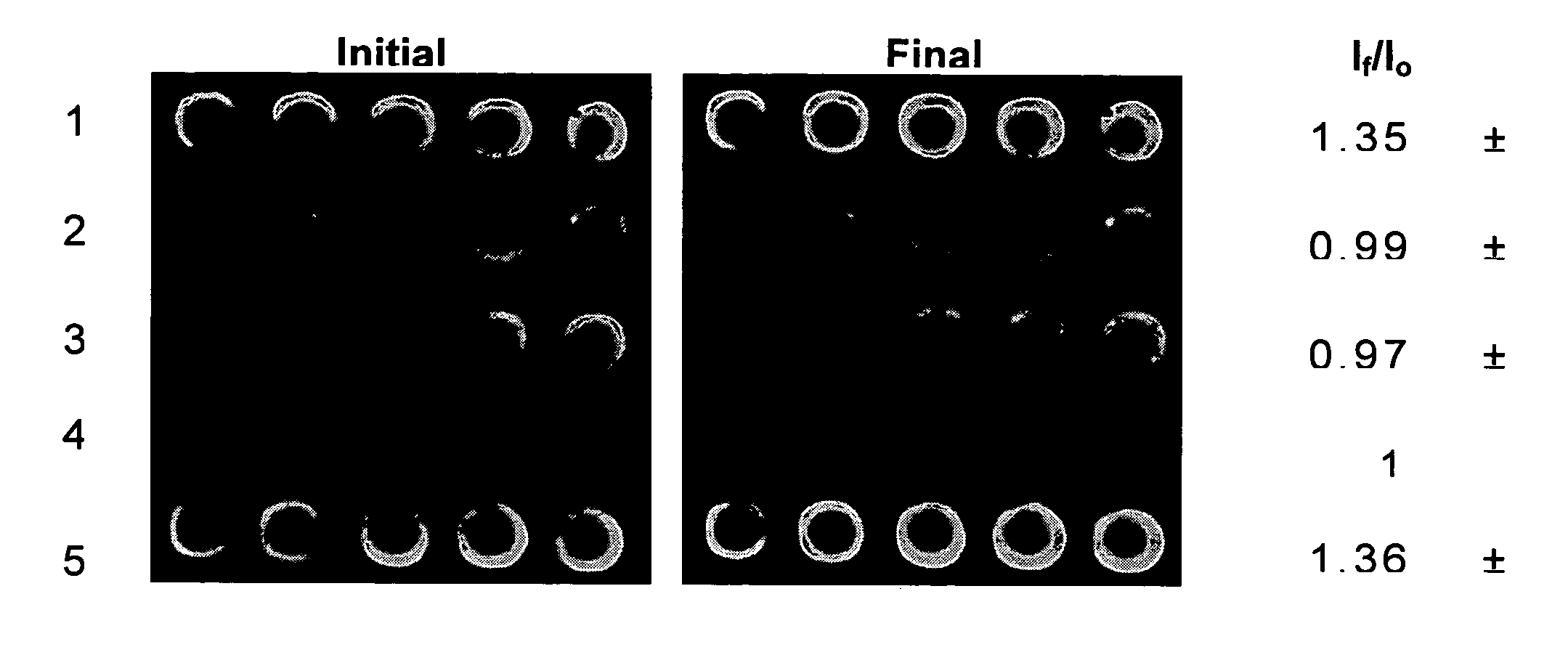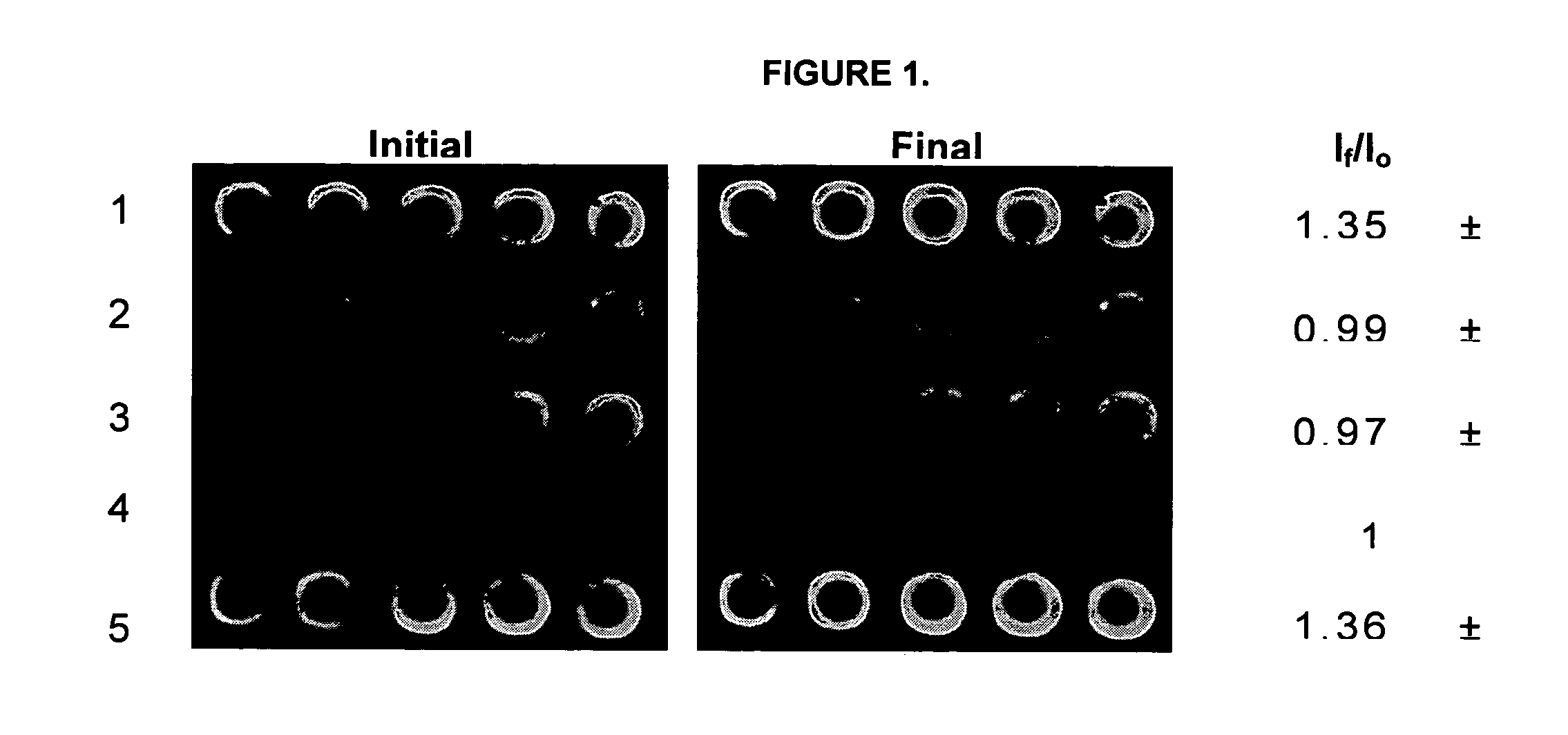Multicomponent protein microarrays
a protein microarray and multi-component technology, applied in the field of protein microarrays, can solve the problems of reducing protein stability, limiting signal-to-noise levels, and time-consuming and costly efforts
- Summary
- Abstract
- Description
- Claims
- Application Information
AI Technical Summary
Benefits of technology
Problems solved by technology
Method used
Image
Examples
example 1
Urease and Fluorescein-labelled Dextran
FIG. 1 shows images of a 5×5 microarray that were prepared for kinetic studies of immobilized urease. The array consisted of four different samples, composing a reagentless enzyme assay array that was suitable for sensing of both substrates and inhibitors. In this array, rows 1 and 5 contained urease that was co-immobilized with fluorescein labelled dextran. Also present in the array were a blank row consisting of only sodium silicate with buffer (negative control, row 2), a row containing only fluorescein dextran 70,000 MW as a pH selectivity control to avoid signals related to drifts in pH that were not based on the enzyme catalyzed reaction (row 3), and a row containing AChE with FD as a selectivity control (row 4). These controls ensured that the enhancement of intensity of any spots in the microarray following addition of urea were solely due to the activity and selectivity of the urease and were not due to drifts in pH or autohydrolysis ...
example 2
Glucose Oxidase and Horseradish Peroxidase
The second protein system that was examined in sol-gel derived microarrays was a more complex system, consisting of two proteins that undergo a coupled reaction. Glucose oxidase reacts with D-glucose to form D-gluconolactone and H2O2 (Scheme 1). In the presence of horseradish peroxidase, the H2O2 then reacts with the Amplex Red reagent in a 1:1 stoichiometry to generate the red fluorescent oxidation product, resorufin, as seen in Scheme 1. Resorufin has absorption and fluorescence emission maxima of approximately 563 nm and 587 nm, respectively, at pH>6 [30,31]
FIG. 4 shows a 5×5 array of Glucose Oxidase / Horseradish Peroxidase co-immobilized in sol-gel derived glass. Columns 1 and 5 contain GOx / HRP co-immobilized with Amplex Red (coupled reaction site). Column 2 contains only buffer and Amplex Red and acts as a negative control. Column 3 contains reacted GOx, HRP, glucose and partially reacted Amplex Red and acts as a positive control. Colu...
example 3
Calmodulin-Melittin Array
FIG. 6 shows an array comprised of co-entrapped calmodulin and melittin before and after exposure to a 20:1 molar ratio of guanidine hydrochloride:CaM. Columns 1&5 contain the protein—protein interaction between CaM and Mellitin. Both of which are labelled with rhodamine. Columns 2&4 are blank and contain only buffer. Column 3 contains CaM—Rhodamine alone and acts as a positive control. Upon addition of GdHCl (2M) to the top of the array and imaging every 20s, the CaM-Mel columns increased in fluorescence over 2-fold (Panel B), while the positive control increased slightly initially but reached a relatively low steady-state value quickly (see graph, FIG. 7)
While the present invention has been described with reference to the above examples, it is to be understood that the invention is not limited to the disclosed examples. To the contrary, the invention is intended to cover various modifications and equivalent arrangements included within the spirit and sc...
PUM
| Property | Measurement | Unit |
|---|---|---|
| width | aaaaa | aaaaa |
| width | aaaaa | aaaaa |
| diameter | aaaaa | aaaaa |
Abstract
Description
Claims
Application Information
 Login to View More
Login to View More - R&D
- Intellectual Property
- Life Sciences
- Materials
- Tech Scout
- Unparalleled Data Quality
- Higher Quality Content
- 60% Fewer Hallucinations
Browse by: Latest US Patents, China's latest patents, Technical Efficacy Thesaurus, Application Domain, Technology Topic, Popular Technical Reports.
© 2025 PatSnap. All rights reserved.Legal|Privacy policy|Modern Slavery Act Transparency Statement|Sitemap|About US| Contact US: help@patsnap.com



